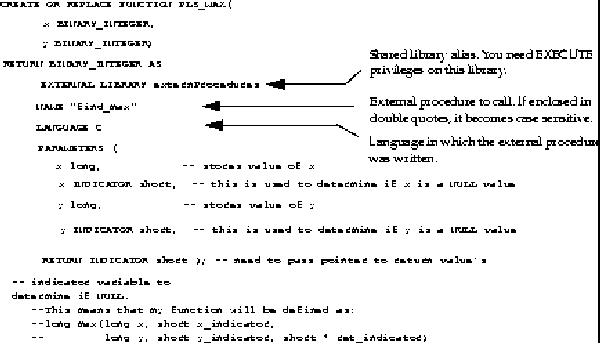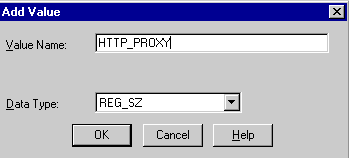Release 8.0.3
A54894-01
Library |
Product |
Contents |
Index |
| Oracle8(TM)
Getting Started for Windows NT Release 8.0.3 A54894-01 |
|
This chapter describes Windows NT-specific issues for applications developers.
Specific topics discussed are:
This section describes how to create and use external procedures on Windows NT.
External procedures are functions written in a third-generation language (3GL), such as C, and callable from within PL/SQL or SQL as if they were a PL/SQL procedure or function. External procedures enable you to take advantage of the strengths and capabilities of a 3GL programming language in a PL/SQL environment. This is done by following the simple five-step process listed below.
The main advantages of external procedures are:
You can use external procedures to perform very specific processes, such as:
To create and use an external procedure, follow the instructions described in the following sections:
This section describes:
To install Oracle8:
Follow the procedures in the Oracle8 Installation for Windows NT CD-ROM Insert to install these products on your Windows NT server:
Contains PL/SQL, from which external procedures are called, and the PL/SQL external procedure program (EXTPROC), which executes external procedures
| Note:
You must also have a 3GL compiler and linker installed on your system to build shared libraries. |
The following Net8 server networking files must be configured to use external procedures:
When PL/SQL calls an external procedure, the Net8 listener launches a session-specific process called EXTPROC. Through the listener, PL/SQL passes the following information to EXTPROC:
EXTPROC then loads the shared library and invokes the external procedure.
If this is a new Oracle8 installation (that is, no TNSNAMES.ORA and SQLNET.ORA files previously existed on the hard drive), the following information is automatically added to your server's TNSNAMES.ORA and LISTENER.ORA files. If these files already exist, edit your client and server Net8 files as follows:
LISTENER = (ADDRESS_LIST = (ADDRESS= (PROTOCOL= IPC) (KEY= oracle.world) ) (ADDRESS= (PROTOCOL= IPC) (KEY= ORCL) ) (ADDRESS= (COMMUNITY= TCP.world) (PROTOCOL= TCP) (Host= inventory.us.company.com) (Port= 1521) ) ) STARTUP_WAIT_TIME_LISTENER = 0 CONNECT_TIMEOUT_LISTENER = 10 TRACE_LEVEL_LISTENER = ADMIN SID_LIST_LISTENER = (SID_LIST = (SID_DESC = (SID_NAME = ORCL) ) (SID_DESC = (SID_NAME = extproc) (PROGRAM=extproc) ) ) PASSWORDS_LISTENER = (oracle)
extproc_connection_data.world = (DESCRIPTION = (ADDRESS = (PROTOCOL=ipc) (KEY=ORCL) ) (CONNECT_DATA=(SID=extproc)) )
Using a 3GL programming language, such as C, you can write functions to be built into shared libraries and invoked by EXTPROC. The following is a simple Microsoft Visual C++ example of an external procedure:
#include <windows.h> #define NullValue -1 /* This function simply returns the larger of x and y. */ long __declspec(dllexport) find_max(long x, short x_indicator, long y, short y_indicator, short *ret_indicator) { /* It can be tricky to debug DLL's that are being called by a process that is spawned only when needed, as in this case. Therefore try using the DebugBreak(); command. This will start your debugger. Uncomment the following line and you can step right into your code. */ /* DebugBreak(); */ /* first check to see if you have any nulls */ /* Just return a null if either x or y is null */ if ( x_indicator==NullValue || y_indicator==NullValue) { *ret_indicator = NullValue; return(0); } else { *ret_indicator = 0; /* Signify that return value is not null */ if (x >= y) return x; else return y; } }
After you have written your external procedure(s) in a 3GL programming language, use the appropriate compiler and linker to build a dynamic link library, making sure to export the external procedures, as noted above. See your compiler and linker documentation for instructions on building a dynamic link library and exporting its functions.
After building the dynamic link library, you can move it to any directory on your system. For the example above, you can build the external procedure find_max into a DLL called externProcedures.
Once you have built a DLL containing your external procedure(s), you must register your external procedure(s) with the Oracle8 database. This involves two distinct steps:
C:\> SVRMGR30
SVRMGR> CREATE LIBRARY externProcedures AS 'C:\ORANT\RDBMS80\ EXTPROC\EXTERN.DLL';
| Note:
The DBA must grant EXECUTE privileges on the PL/SQL library to users that want to call the library's external procedures from PL/SQL or SQL. |
Do this by writing a PL/SQL subprogram that uses the EXTERNAL clause instead of declarations and a BEGIN...END block. The EXTERNAL clause is the interface between PL/SQL and the external procedure. The EXTERNAL clause identifies the following information about the external procedure:
For example:

To execute an external procedure, you must call the PL/SQL program that registered the external procedure. These calls can appear in:
In the section "Step 4: Registering an External Procedure", the PL/SQL function PLS_MAX registered the external procedure find_max. Follow the procedures below to execute find_max:
CREATE OR REPLACE PROCEDURE UseIt AS a integer; b integer; c integer; BEGIN a := 1; b := 2; c := PLS_MAX(a,b); dbms_output.put_line('The maximum of '||a||' and '||b||' is '||c); END;
SVRMGR> EXECUTE UseIt;
See the following documents for additional information on external procedures:
The XA Application Program Interface (API) is typically used to enable an Oracle8 database to interact with a transaction processing (TP) monitor, such as:
The Oracle XA Library is automatically installed as part of the Oracle8 installation option. The following components are created in your Oracle home directory:
| Component | Location |
|---|---|
|
XA80.DLL |
ORACLE_HOME\BIN |
|
XA80.LIB |
ORACLE_HOME\RDBMS80\XA |
|
XA.H |
ORACLE_HOME\RDBMS80\XA |
You can also use TP monitor statements in your client programs. The use of the XA API is also supported from both Pro*C and Oracle Call Interface (OCI). In either case, the XA80.DLL must be contained in the execution path of the calling program.
To compile and link a Pro*C program:
| Library | Located in... |
|---|---|
|
XA80.LIB |
ORACLE_HOME\RDBMS80\XA |
|
ORA803.LIB |
ORACLE_HOME\OCI80\LIB |
|
SQLLIB80.LIB |
ORACLE_HOME\PRO80\LIB\MSVC |
|
|
or |
|
|
ORACLE_HOME\PRO80\LIB\BORLAND |
To compile and link an OCI program:
| Library | Located in... |
|---|---|
|
XA80.LIB |
ORACLE_HOME\RDBMS80\XA |
|
ORA803.LIB |
ORACLE_HOME\OCI80\LIB\MSVC |
|
|
or |
|
|
ORACLE_HOME\OCI80\LIB\BORLAND |
See the following general information about XA and TP monitors:
For more information about the Oracle XA Library, see the chapter "Oracle XA" of the Oracle8 Server Application Developer's Guide.
You must add a parameter to the registry before using Intercartridge Exchange (ICX).
To configure ICX:
C:\> REGEDT32
The Add Value dialog box appears.


where your-site is your web site.
Intercartridge Exchange (ICX) enables you to use a stored package called UTL_HTTP to make hypertext transfer protocol (HTTP) calls from PL/SQL, SQL, and Server Manager statements. UTL_HTTP can:
UTL_HTTP contains two similar entry points, known as packaged functions, that make HTTP callouts from PL/SQL and SQL statements:
Both packaged functions:
The declarations to use with both packaged functions are described below:
UTL_HTTP.REQUEST takes a URL as its argument and returns up to the first 2000 bytes of data retrieved from the given URL.
UTL_HTTP.REQUEST is specified as:
FUNCTION REQUEST (URL IN VARCHAR2) RETURN VARCHAR2;
To use UTL_HTTP.REQUEST from Server Manager, enter:
SVRMGR> SELECT UTL_HTTP.REQUEST('HTTP://WWW.ORACLE.COM/') FROM DUAL;
which outputs:
UTL_HTTP.REQUEST('HTTP://WWW.ORACLE.COM/')
------------------------------------------------------
<html> <head><title>Oracle Corporation Home Page</title> <!--changed Jan. 16, 19 1 row selected.
UTL_HTTP.REQUEST_PIECES takes a URL as its argument and returns a PL/SQL table of 2000 bytes of data retrieved from the given URL. The final element may be shorter than 2000 characters. The UTL_HTTP.REQUEST_PIECES return type is a PL/SQL table of type UTL_HTTP.HTML_PIECES.
UTL_HTTP.REQUEST_PIECES, which uses type UTL_HTTP.HTML_PIECES, is specified as:
type html_pieces is table of varchar2(2000) index by binary_integer; function request_pieces (url in varchar2, max_pieces natural default 32767) return html_pieces;
A call to REQUEST_PIECES can look like the example below. Note the use of the PL/SQL table method COUNT to discover the number of pieces returned, which may be zero or more:
declare pieces utl_http.html_pieces; begin pieces := utl_http.request_pieces('http://www.oracle.com/'); for i in 1 .. pieces.count loop .... -- process each piece end loop; end;
The second argument to UTL_HTTP.REQUEST_PIECES, (MAX_PIECES) is optional. MAX_PIECES is the maximum number of pieces (each 2000 characters in length, except for the last, which may be shorter), that UTL_HTTP.REQUEST_PIECES returns. If provided, that argument is likely a positive integer.
For example, the following block retrieves up to 100 pieces of data (each 2000 bytes, except perhaps the last) from the URL. The block prints the number of pieces retrieved and the total length, in bytes, of the data retrieved.
set serveroutput on / declare x utl_http.html_pieces; begin x := utl_http.request_pieces('http://www.oracle.com/', 100); dbms_output.put_line(x.count || ' pieces were retrieved.'); dbms_output.put_line('with total length '); if x.count < 1 then dbms_output.put_line('0'); else dbms_output.put_line ((2000 * (x.count - 1)) + length(x(x.count))); end if; end; /
which outputs:
Statement processed. 4 pieces were retrieved. with total length 7687 The elements of the PL/SQL table returned by UTL_HTTP.REQUEST_PIECES are successive pieces of data obtained from the HTTP request to that URL.
This section describes the exceptions that can be raised by packaged functions UTL_HTTP.REQUEST and UTL_HTTP.REQUEST_PIECES:
The PRAGMA RESTRICT_REFERENCES enables exceptions (errors) to be displayed:
create or replace package utl_http is function request (url in varchar2) return varchar2; pragma restrict_references (request, wnds, rnds, wnps, rnps);
The PRAGMA RESTRICT_REFERENCES enables exceptions (errors) to be displayed:
create or replace package utl_http is type html_pieces is table of varchar2(2000) index by binary_integer; function request_pieces (url in varchar2, max_pieces natural default 32767) return html_pieces; pragma restrict_references (request_pieces, wnds, rnds, wnps, rnps);
Do not expect UTL_HTTP.REQUEST or UTL_HTTP.REQUEST_PIECES to succeed in contacting a URL unless you can contact that URL by using a browser on the same machine (and with the same privileges, environment variables, etc.). If UTL_HTTP.REQUEST or UTL_HTTP.REQUEST_PIECES fails (that is, if it raises an exception or returns an HTML-formatted error message, yet you believe that the URL argument is correct), try contacting that same URL with a browser to verify network availability from your machine.